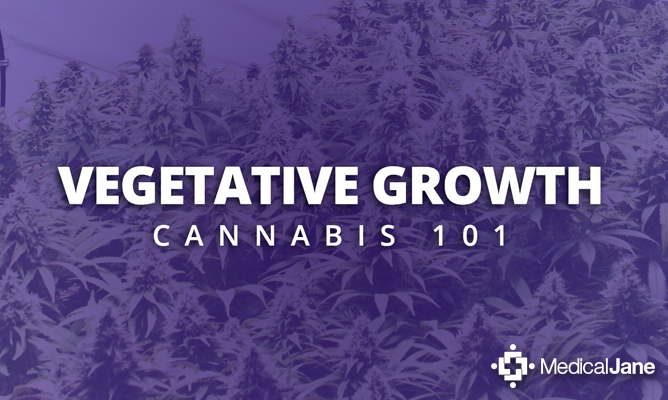
Pre-Veg and Vegetative Growth Management in Medicinal Marijuana Crops
Our last article in this series about growing quality medical marijuana discussed why plant propagation is such an important step in the process. We also learned about the differences in starting from seed versus clones and how to perform these two very important processes in a reliable and easy to follow method.
Once plants have developed a small root system and can support their water intake needs without a humidity dome, most people will say it’s time to step into the next phase of marijuana crop development: vegetative growth. However, it’s important that we don’t miss a very important step called the pre-veg phase. Let’s examine the significance and how it fits into your overall cropping cycle.
Pre-Vegetative (Pre-Veg) Phase of Growth
During propagation, your plants developed a small root system and gained their first new true set of leaves. Next, they need to build sufficient structure both in the root and aerial environment to support your target yields.
To get a fair yield in return for your efforts and expense, you need to be able to fill the growing environment you created with as many budding sites as possible while still providing strong light in all areas to support dense yields of high quality medicinal cannabis.
Give your freshly propagated plants 5-10 days in a transitional phase between propagation and full-on vegetative growth conditions. This helps them get acclimated to more intensive growing conditions.
After a successful pre-veg phase, increasing lighting and air movement for full-on veg will garner explosive growth rather than making your plants stressed or sickly. Focus on developing roots and getting the leaves used to the drier, quicker moving air.
If you grow in soilless mix and have rooted starter plugs, something the size of a plastic beer cup is the perfect size for this stage. Too big a container and it will stay too wet before it needs watering again. Water logged roots will stifle growth, or worse.

Vegetative Phase of Growth
You will want to know how much more you can expect your cannabis plants to grow in height after you trigger the budding cycle (aka the stretch). This is often expressed as a percentage (+100%) or as a proportion. This information is super important, because it will let you know how big the plants should be before you switch to bud in order for your grow room to fill nicely based on your plant count and spacing.
“If you have higher plant numbers in the same area, it won’t take as much time to fill out the space later in bud, so less time would be required in veg.”
If you have higher plant numbers in the same area, it won’t take as much time to fill out the space later in bud, so less time would be required in veg.
The opposite would be true for a smaller number of plants in the same space: more veg time is required for them to get big enough to fill the space.
The reason you’ll want to know your strain is that different genetics will behave differently in terms of how much they will stretch before the budding sites start to fill out into large sticky colas. You don’t want to run out of space, or plants will get burned growing too close to the lights. Conversely, if they don’t fill out the garden area by the time buds start to swell, you run the risk of having a lower yield. It can take a while to learn a strain, and how to grow it for the optimum yield and quality.
Indica strains tend to not grow too much after changing the light cycle to stimulate bud production — +25% would be the average. Most Sativas recommended for growing indoor under lights can grow +150%. Hybrids can have traits anywhere in between. Some of the more rare and exotic strains can reach heights of six feet tall from plants grown from seed that were only eight inches tall when budding was initiated. However, this is not the normal selection or strain type most indoor growers will attempt.
Your environment will also have an influence on growth rates after budding starts, and therefore will have bearing on your time in the vegetative growth phase. Higher humidity levels tend to make plants stretch more, for example, as do lower light intensities. Conversely a strong flow of air across the tops of plants will help keep them shorter and bushier; a good trait for growing indoors with vertical limitations.

Tips To Consider During The Vegetative Phase Of Growth
As you should have noticed by now, there is more to vegetative growth than just meeting the right environmental factors. The process is a very important tool in managing how much biomass will be in your garden for the number of plants you are working with.
For vegetative growth, here are some fundamental rules that you can adapt to your own growing style, set-up and strain selection:
- Light Cycle: as long as the plants receive no more than 10 to 12 hours of uninterrupted darkness they will remain in the vegetative growth phase, with the exception of auto-flowering strains. Some growers maintain a constant 24/7 lights on period, while others prefer a 18 hours ON and 6 hours OFF in order to let the room cool down. Full spectrum lighting is recommended for veg.
- Temperature: Usually 75°-85° F when the lights are ON and 70°-75° F when the lights are OFF is optimal.
- Relative Humidity (RH): anywhere from 45 to 75% is fine. Be careeful it doesn’t get excessively high in the dark cycle with cooler temperatures.
- Air Flow: Having a steady breeze blowing through the plant canopy is important. Start off gentle when plants are young and increase velocity as plants get established.
- CO2: Carbon dioxide is fuel for plant growth. When plants are smaller, GreenPadCO2 or other easy safe and affordable sources can give a great boost in any garden. Large-scale gardens will need a tank or CO2 burner.
Following these guidelines should get your plants charging forward fast and strong towards building the structure needed for the medical marijuana yield of your dreams. There is still much to do along the way to help ensure success and a bountiful harvest of quality buds, and we will discuss them in more detail next time you check back for the latest installment in our series about home-cultivation.
Erik Biksa has been writing about and discussing hydroponics growing, related technologies and cropping methods since 1999 in a variety of professional publications and platforms globally Erik has travelled the world learning and teaching modern …

